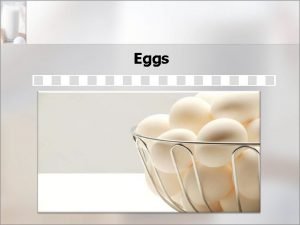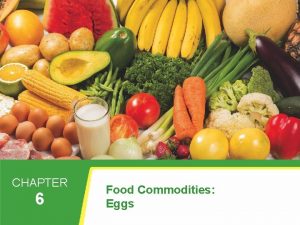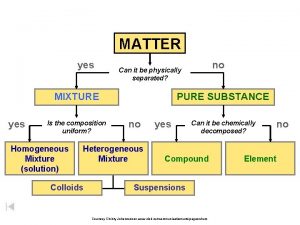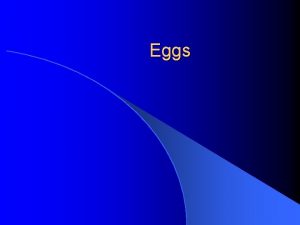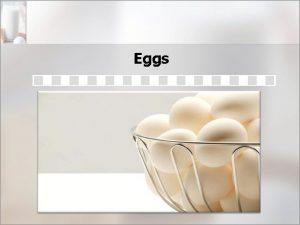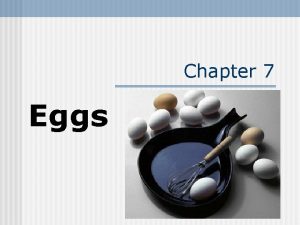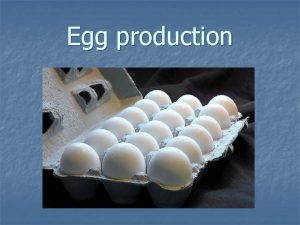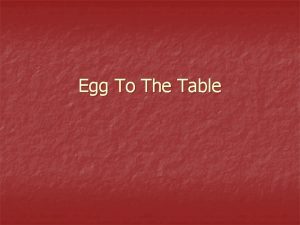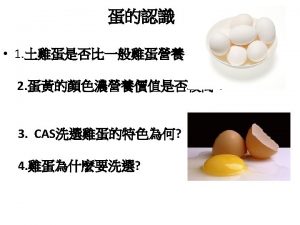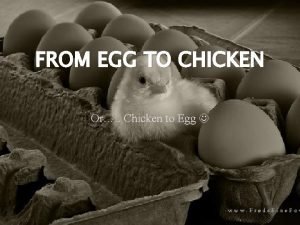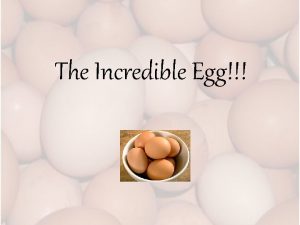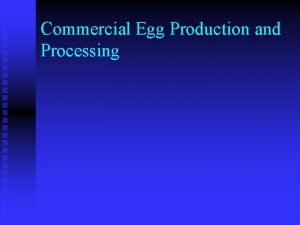Eggs Composition of eggs n The egg has

















































- Slides: 49

Eggs

Composition of eggs n The egg has five major components: n Yolk n Albumen (egg white) n Shell membranes n Air cell n Shell


n Yolk: The sunny yellow yolk situated in the center of the egg constitutes about 30 % of the egg's weight. It dense in nutrients, it contain all the fat-soluble vitamins. It high in fat and cholesterol (averaging 213 mg in a large egg). The colors of the yolk, ranging from pale yellow to deep red, depends on the hen's diet.

n Albumen (egg white): It accounts (58%) of an egg's weight. It made up largely of water and protein and contain certain water-soluble B vitamin (B 3, B 5, biotin, folate and B 12). The egg white is actually constructed of layers different in viscosity, alternating from thick to thin, thus due to the type and amount of protein. Around the yolk is a layer of thick protein called albumin.

n The chalaza at the top and bottom of the egg anchor the egg yolk in the thick egg white surrounding it. They also secure the yolk to its vitelline membrane so it stays neatly centered in the middle of the egg. n Shell membranes: Between the egg white and the shell are two membranes, an inner and outer shell membrane. These protect the egg against bacterial invasion.

n Air cell: Between the two shell membranes at the large end of the egg. n Shell: It protect the egg (12% of an egg weight). It contain thousands of small pores allowing an exchange of gas between the inner egg and the surrounding air. Shell color indicates the breed of the hen, brown eggs tend to cost more because they usually come from larger hens, which require more food and produce fewer

n Shell: It protected by the cuticle or bloom. So washed egg removes this protective cuticle. Producers applying a thin coat of edible oil on the shell.

Composition of Eggs n Chalaza: The ropy, twisted strands of albumen that anchor the yolk to the center of the thick egg white. n Vitelline membrane: The membrane surrounding the egg yolk and attached to the chalazae. n n Cuticle (bloom): A waxy coating on an eggshell that seals the pores from bacterial contamination and moisture loss.

Egg proteins Egg white proteins: v Ovalbumin: It account more than half of all the protein. It plays an important role in egg preparation because it gels well and denatures easily when heated. v Ovotransferrin (Conalbumin): It helps to protect against bacterial contamination by forming a complex with iron, thereby making it unavailable to bacteria, which need to growth. v Ovomucoid: Resistant to denaturation, it inhibit the activity of trypsin, an enzyme that breaks down specific proteins. v Ovimucin: It helps protect against microbial damage by reacting with viruses.

Egg proteins v Avidin: In uncooked egg binds to the B-vitamin (biotin) and prevent it from being absorbed by the small intestine, however, once cooked it denatures. Egg yolk proteins: v Lipoproteins- Lipovitellin and Lipovitellinin: Acts as emulsifiers in food preparation.

Purchasing eggs n Grading The best-quality eggs are Grade AA, followed by Grade A. Grade B, the lowest grade.

Purchasing Eggs n Candling: A method of determining egg quality based on observing eggs against a light to view its contents.

Purchasing eggs How does candling reveal if an egg is fresh or aged? v The yolk in a fresh eggs is suspended tightly by the chalazae (seen as a slight shadow), in older eggs are surrounded by thinning, clearer egg whites and lie closer to the shell because they are no longer suspended well by the chalazae (seen as a darker shadow). v The whites become more thin and transparent as carbon dioxide departs through the shell. v The yolk membrane stretches as the yolk absorbs water from the white, which eventually will cause the yolk to break easily when the shell is cracked. v The egg's air cell becomes wider or moves as the egg ages.

The egg's air cell becomes wider as the egg ages

Purchasing eggs n Sizing It is not related to grading in any way. Eggs are sold in cartons by various sizes determined by a minimum weight for a dozen eggs in their shell.

Functions of eggs in foods n n Eggs are often combined with other ingredients. Their unique ability to: n Flavor n Color n Emulsify n Thicken n Bind n Foam n Interfere …makes them nearly indispensable in cooking.

Functions of eggs in foods q Emulsifying: Lecithin found in the egg yolks is a natural emulsifying agent, it help keep fat and water or other liquid compounds from separating, so they are often used to thicken and stabilize foods ex. mayonnaise. q Foaming: The capacity of egg white to be beaten into a foam that increases to six or eight times its original volume. It is invaluable in food preparation, such as sponge cake.

Foaming Why do beaten egg whites make a stable foam? q Vigorous beating or whisking of egg whites breaks the links between protein molecules, causing the protein molecule coil to unwind or become denatured. q The foam structure is created when the unfolded proteins rearrange to construct films around the air cells. q When the airy foam is heated, its air cells further expand, after which the egg proteins coagulate, solidifying the egg protein to create a firm, stable structure, higher in height than the same food made without egg-white foam.

Foaming q The best eggs to use for an egg-white foam are fresh eggs because: Fresh eggs have thick egg whites, which contribute to a stable foam. Older eggs have thinner whites, which beat to a larger volume but are less stable and may collapse during heating.

Factors affect the formation and stability of egg white 1 -Beating technique: v Egg whites are best beaten with an electric mixer, but a wire whisk can be used, whichever device is used, it must to whip the egg whites into very fine, delicate bubbles. v At first, beating speed should be moderately, when the egg whites are half whipped and beginning to hold their shape, the beating speed should be increased to fast. v Beating should continue until the peaks are stiff and shiny but not dry.


v It is important to beat egg whites to the correct stage, because both over- and under-beaten foams will collapse and separate into liquid pools at the bottom of the bowl. v Avoiding over-whipping: Thus occurs when the peaks stand tall, dry and are no longer shiny. The protein films surrounding the air cells rupture, creating bubbles that are too large and unstable.

Factors affect the formation and stability of egg white: 2 -Temperature: v The bowl, beater and eggs should be at room temperature. v To decreased surface tension, room temperature egg whites allows them to whip more easily and to a larger volume than cold eggs. v The stability of the foam deteriorates with continued exposure to room temperature.

Factors affect the formation and stability of egg white: 3 -Type of bowl: v Deep bowls with rounded bottoms sloping up into the sides are best. v They allow the egg whites to be picked up by the beater. v Plastic bowls should be avoided, because their porous surface may harbor a thin film of grease from previous usage, which could interfere with foam formation.

Factors that affect the formation and stability of egg white: 4 -Separation of eggs: v Careful separation of the egg yolk and the white is imperative. v Eggs can be separated using an egg separator. v Eggs should not be separated by passing the yolk back and forth between the two shell halves, also egg yolk traces should not be removed by using the egg's shell, because egg shells are a possible source of microbial contamination.

Factors affect the formation and stability of egg white: 5 -Adding sugar: v Sugar stabilized egg-white foam, but it also inhibits the mechanical coagulation of proteins necessary for foam formation. v Therefore, it is best to add sugar near the end of the whipping time. v One teaspoon of superfine sugar /egg may be added only after soft white peaks have formed. v Egg white sweetened with sugar is less likely to be overbeaten, and has a very fine texture with a smooth, satiny surface.

Factors affect the formation and stability of egg white: 6 -Adding fluid: v Adding fluid to egg whites increases the foam volume up to 40 % but decreases its stability. 7 -Adding salt: v Salt decreases the stability and volume of egg- white foam, and for that reason is rarely added to egg whites.

Factors affect the formation and stability of egg white: 8 -Adding acid: v Whole egg p. H (7 -7. 6 neutral), but egg whites p. H (8. 4 alkaline), alkalinity increases with age as eggs lose carbon dioxide, which increases the p. H of the whites (up to 9. 2). v Egg whites whip more easily into a stable foam when their p. H is lowered slightly. v Adding acid (lemon juice, vinegar…) decreases the p. H of egg whites, causing the egg proteins to become unstable and more likely to denature and whip into a foam. v Adding too much acid, resulted in delayed foam formation and a much less stable foam.

Preparation of eggs Egg can be prepared alone or in combination with other foods. Changes in prepared eggs n The key to cooking eggs is to keep the temperature low and/or the cooking time short. n Heating eggs at high temp. and/or long periods of time diminishes the eggs' texture, flavor and color. n Overheated proteins become tough and rubbery and shrink from dehydration, which is why overcooked scrambled eggs look curdled and fell dry and rubbery.

Preparation of eggs Coagulation temperature: n Egg whites and yolks coagulate at different temperatures. n Egg white first start to coagulate at (60°C) and become completely coagulated at (65 -70°C). n Egg yolk first start to coagulate at (62 -70°C). n This difference explain why whites cooked egg could be firm but yolks remain soft?

Preparation of eggs Effect of added ingredients: n Adding milk into whole eggs in a custard dish increases the coagulation temp. to (79°C). n Sugar increases coagulation temp. n Addition of salt and/or acid lowers it. n Eggs can curdle if two much of an acid such as tomato is added.

Preparation of eggs Color changes: n Undesirable color changes may occur during egg preparation. n In overcooked or heated at too high temp. the sulfur in the egg white may combined with the iron in the yolk to form ferrous sulfide, a green-colored compound with a strong odor and flavor. n To eliminate the green-yolk this done by: Use stainless steel equipment- low cooking temp. - avoid overcookingcool hard-cooked eggs quickly in cold water (the rapid temp. drop lower the pressure within the egg, and the hydrogen sulfide gas does not enter the yolk)- serve them immediately.

Preparation of eggs The green ring around the yolk is from the sulfur Sulfur (whites; hydrogen sulfide gas) move under high temp. to the yolk. There it combines with the iron in yolk to form ferrous sulfide. The result is a greenish ring around the yolk

Preparation of eggs Color changes: n Another change, which is more difficult to prevent in heated eggs is the slight browning that results from the Maillard reaction, in which egg proteins react with the few carbohydrates that exist in an egg.

Dry-heat preparation n n Dry-heat preparation of eggs primarily involves frying and baking. Egg dishes that are commonly fried are fried eggs, scrambled eggs, and omelets. Fried eggs: Yolks are less likely to break open when the eggs are cracked by using fresh eggs and/or by first breaking the eggs into a bowl or other container rather than dropping them directly from the shell into a frying pan. The heat should be lowered immediately to medium-high. Coagulation is often allowed to occur according to the following “cook- to order” stage:

Dry-heat preparation n n Sunny side up: The egg is cooked until the white is set and the yolk is still soft, the egg is not flipped. Over easy: The eggs are flipped over when the whites are 75% set, cooking until the whites are completely cooked but the yolks are still soft. Over medium: The same as over easy expect that the yolks are partially set. Over hard: The same as over easy expect that the yolks are completely set.

Dry-heat preparation n n Scrambled: The scrambled egg are beaten while raw until well blended and may be seasoned with salt and pepper. Liquid (milkwater) or cream may be added to impact more body and/or flavor and a soft, creamy texture. Omelets: Eggs are beaten, cooked and rolled into a cigar shape.

Moist-Heat Preparation n Eggs can be prepared by moist heat using a variety of methods, such as: n “Boiled” eggs n Poached eggs n A variety of custards n Eggs that are prepared using the microwave.

Hard or Soft “Boiled” Eggs should be cooked at simmering temperatures and never boiled, because they will become tough and rubbery if so treated. The high heat also causing the greenish-black color and unpleasant flavor in the yolk.

Why do boiled eggs sometimes crack? Eggs crack because the pressure created by fast-heating waster pops the shell. This can be avoided by : v. First v To warming eggs to room temp. push a sterilized pin or needle through the large end of the shell where the air cell is located. v. A spoon or other utensil may be used to place the eggs gently in the water

Custards §Custards are mixtures of milk and/or cream, sweeteners (sugar/honey) flavorings (vanilla) and eggs or eggs yolks. §Custards are thickened by the coagulation of egg proteins during cooking. §These egg proteins denature when heated and recombine to form a network that sets or coagulates at the right temp. to form the solid gel of a custard. §All custard dishes are vey susceptible to microbial contamination, and should be covered and refrigerated as soon as possible after preparation. §Custards are distinguished by their preparation methods, stirred or baked.

Custards Stirred custards (soft custard or custard sauce): §The ingredients are stirred while being heated on the range over low heat or in double boiler. §The repeated stirring prevents the formation of a gel, so the custard mixture thickens instead of gels. §The mixture retains a smooth, creamy, fluid consistency. §It is often eaten as a pudding, or it may be provide the base for many frozen desserts.

Custards Baked custards: §It is actually an example of dry-heat preparation. §The same ingredients are poured into ungreased custard cups that are placed in the oven, usually water bath, where they sit undisturbed and gel during baking. §The layer of water insulates the cups and prevents the outside of the custard from cooking to completion before the inside has had a chance to coagulate.

Custards Overheating: §The internal temp. of custards should never be allowed to rise above the point of coagulation of the egg-liquid mixtures (85°C). §Overheating causes the egg proteins to shrink, allowing liquid to be released from the egg and producing a product with a curdled, weepy, porous appearance. §Custards tend to have a runny texture, which makes them unsuitable for making solid pie fillings, therefore it should thickened with starch (cornstarch or flour)

Custards Overheating: § Custards should be baked at (177°C), until a knife inserted in the middle of the cup comes out clean (about 25 min. ). § Just before complete doneness is reached, the custard is immediately removed from the oven and placed on a rack. § Some additional cooking will inevitably occur during cooling, but can be minimized by using a cooling rack. § Undercooking should likewise be avoided, because it will prevent the custard from setting properly.

Storage of eggs Refrigerator: n n Eggs begin to deteriorate as soon as they are laid and lose quality very rapidly at room temperature. An egg will age more in one day at room temperature than in one week in the refrigerator. Proper refrigeration of eggs helps to protects them from microbial growth and maintain their quality. Eggs retain their moisture better and keep longer if stored in the carton rather than build-in egg container in refrigerators.

Storage of Eggs n n Eggs should be sit in the carton with their large ends up to prevent the air cell from moving toward the yolk. Washing eggs is not recommended, because this will remove the oil coating applied by the processor to prevent microbial growth and moisture loss. Frozen: n Freezing a whole egg is not possible because it will crack under the expanding liquids.

Safety tips There are many precautions that can be taken to prevent food borne illness from eggs: n Use an eggs separator rather than passing the yolk back and forth between the two shell halves. n Use purified water for boiled and cooled eggs, due to the egg can absorbing bacteria through the pores. n Always store eggs in the refrigerator, never at room temp. Eggcontaining foods should be refrigerated until served. n Raw eggs should never be consumed. n Do not add raw eggs to already scrambled eggs. n Cook eggs until no visible liquid egg remains. n All egg dishes should be heated to (63°C).
 Chapter 18 eggs selecting and storing eggs
Chapter 18 eggs selecting and storing eggs Composition of egg
Composition of egg East egg vs west egg
East egg vs west egg West egg and east egg
West egg and east egg West egg vs east egg
West egg vs east egg The great gatsby setting
The great gatsby setting Why is nick carraway made the narrator?
Why is nick carraway made the narrator? West egg vs east egg
West egg vs east egg West egg and east egg
West egg and east egg Egg
Egg Egg white composition
Egg white composition Egg white composition
Egg white composition What is a uniform composition
What is a uniform composition Hát lên người ơi
Hát lên người ơi Sự nuôi và dạy con của hổ
Sự nuôi và dạy con của hổ đại từ thay thế
đại từ thay thế Vẽ hình chiếu vuông góc của vật thể sau
Vẽ hình chiếu vuông góc của vật thể sau Công thức tiính động năng
Công thức tiính động năng Tỉ lệ cơ thể trẻ em
Tỉ lệ cơ thể trẻ em Thế nào là mạng điện lắp đặt kiểu nổi
Thế nào là mạng điện lắp đặt kiểu nổi Dạng đột biến một nhiễm là
Dạng đột biến một nhiễm là Lời thề hippocrates
Lời thề hippocrates Vẽ hình chiếu đứng bằng cạnh của vật thể
Vẽ hình chiếu đứng bằng cạnh của vật thể Quá trình desamine hóa có thể tạo ra
Quá trình desamine hóa có thể tạo ra độ dài liên kết
độ dài liên kết Môn thể thao bắt đầu bằng chữ đua
Môn thể thao bắt đầu bằng chữ đua Khi nào hổ mẹ dạy hổ con săn mồi
Khi nào hổ mẹ dạy hổ con săn mồi điện thế nghỉ
điện thế nghỉ Thế nào là sự mỏi cơ
Thế nào là sự mỏi cơ Trời xanh đây là của chúng ta thể thơ
Trời xanh đây là của chúng ta thể thơ Voi kéo gỗ như thế nào
Voi kéo gỗ như thế nào Thiếu nhi thế giới liên hoan
Thiếu nhi thế giới liên hoan Phối cảnh
Phối cảnh Các châu lục và đại dương trên thế giới
Các châu lục và đại dương trên thế giới Một số thể thơ truyền thống
Một số thể thơ truyền thống Thế nào là hệ số cao nhất
Thế nào là hệ số cao nhất Sơ đồ cơ thể người
Sơ đồ cơ thể người Tư thế ngồi viết
Tư thế ngồi viết Các số nguyên tố
Các số nguyên tố đặc điểm cơ thể của người tối cổ
đặc điểm cơ thể của người tối cổ Hình ảnh bộ gõ cơ thể búng tay
Hình ảnh bộ gõ cơ thể búng tay Mật thư tọa độ 5x5
Mật thư tọa độ 5x5 Chụp phim tư thế worms-breton
Chụp phim tư thế worms-breton ưu thế lai là gì
ưu thế lai là gì Thẻ vin
Thẻ vin Thể thơ truyền thống
Thể thơ truyền thống Cái miệng xinh xinh thế chỉ nói điều hay thôi
Cái miệng xinh xinh thế chỉ nói điều hay thôi Các châu lục và đại dương trên thế giới
Các châu lục và đại dương trên thế giới Bổ thể
Bổ thể Từ ngữ thể hiện lòng nhân hậu
Từ ngữ thể hiện lòng nhân hậu

